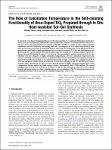Thông tin tài liệu
Thông tin siêu dữ liệu biểu ghi
| Trường DC | Giá trị | Ngôn ngữ |
|---|---|---|
| dc.contributor.author | Lukong, Valantine Takwa | - |
| dc.contributor.author | Chukwuati, Christopher Nonso | - |
| dc.contributor.author | Ukoba, Kingsley | - |
| dc.date.accessioned | 2023-10-06T08:26:39Z | - |
| dc.date.available | 2023-10-06T08:26:39Z | - |
| dc.date.issued | 2023 | - |
| dc.identifier.uri | https://link.springer.com/article/10.1007/s11665-023-08727-2 | - |
| dc.identifier.uri | https://dlib.phenikaa-uni.edu.vn/handle/PNK/9496 | - |
| dc.description | CC-BY | vi |
| dc.description.abstract | In this study, urea-doped titanium dioxide (urea-TiO2) nanoparticles were synthesized through an in situ heat-assisted sol–gel technique using titanium (IV) isopropoxide as the precursor for titanium dioxide and urea as a nitrogen source. The nanoparticles were calcined at 300, 500, and 700 °C to study the effect of the calcination temperature on their function as self-cleaning material. The nanoparticles were characterized using a scanning electron microscope and a transmission electron microscope for morphology, X-ray diffraction, Raman spectroscopy, and Fourier transformed infrared spectroscopy for structure, UV–Vis, and photoluminescence spectroscopy for optical analysis. The self-cleaning study was carried out by letting samples degrade methylene blue and Rhodamine-B under UV irradiation. The morphological analysis reveals particle size distribution with more disparity at higher calcination temperatures. | vi |
| dc.language.iso | en | vi |
| dc.publisher | Springer | vi |
| dc.subject | urea-TiO2 | vi |
| dc.subject | UV irradiation | vi |
| dc.title | The Role of Calcination Temperature in the Self-cleaning Functionality of Urea-Doped TiO2 Prepared through In Situ Heat-Assisted Sol–Gel Synthesis | vi |
| dc.type | Book | vi |
| Bộ sưu tập | ||
| OER - Khoa học Vật liệu, Ứng dụng | ||
Danh sách tệp tin đính kèm:

